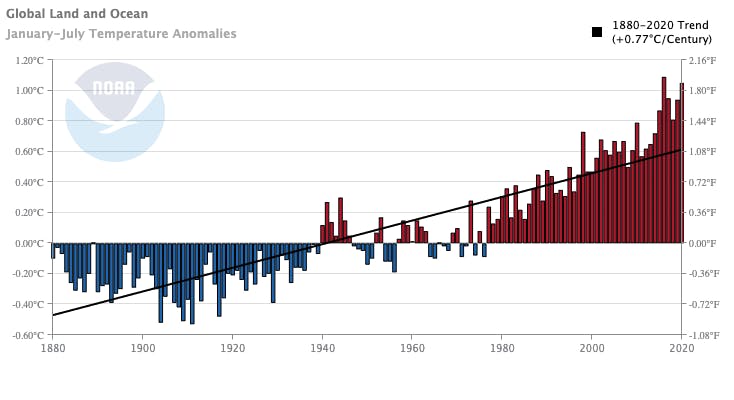I’m very excited about The LaunchDarkly Foundation’s contribution to Stripe Climate. Climate change is an existential threat to life as we know it on Earth, the poorest and most vulnerable people will be the first to suffer. Climate change is one of the three focus areas of the LaunchDarkly Foundation, and carbon removal seems like an effective way to help support that.
Stripe, valued at $95B, is an unlikely recipient of LaunchDarkly’s philanthropic efforts. Why would we give money to an incredibly valuable tech company, as opposed to a traditional nonprofit organization? We chose Stripe Climate because they’re lowering the price of carbon removal, thus making this effort a more scalable solution.
The situation
Earth is getting hotter, which is bad. The last five years have been the hottest on record. XKCD has a great visual of global temperature rise over the last 20,000 years, but the chart is so big that it won’t fit in this blog post. This one from the National Oceanic and Atmospheric Administration (NOAA) will have to do instead:

If temperatures continue to rise, the Earth will face a cataclysmic environment. And the poorest people, who contribute the least to the problem, will bear the brunt of the effects. In order to address this, two things are important: emit less carbon and remove carbon from the atmosphere. Emitting less carbon is necessary, but even if humanity managed to stop emitting carbon into the atmosphere tomorrow, it would take 10,000 years for the Earth’s carbon cycle to bring atmospheric carbon to pre-industrial levels. Which brings us to Stripe Climate.
Stripe Climate
Stripe Climate, a project of the payments company Stripe, pays startup for-profit companies to remove carbon from the atmosphere. They do not take any equity or ownership; they act like a customer and purchase carbon by the ton. Stripe agrees to pre-purchase the carbon removal at the market price. This price is often high, as these organizations are very early in their development and operating at a small scale.
These purchases provide a critical demand signal in the market. For 7 of the 10 companies Stripe Climate buys from, they were the first customer. These purchases lay the foundation for proving the commercial viability of this market, allowing investors and entrepreneurs to move into the space. Here are some of the projects they have bought carbon from:
- Climeworks uses renewable geothermal energy and waste heat to capture CO₂ directly from the air, concentrate it, and permanently sequester it underground in basaltic rock formations with Carbfix.
- Charm Industrial has created a novel process for preparing and injecting bio-oil into geologic storage. Bio-oil is produced from biomass and maintains much of the carbon that was captured naturally by the plants. By injecting it into secure geologic storage, they’re making the carbon storage permanent.
- Project Vesta captures CO₂ by using an abundant, naturally occurring mineral called olivine. Ocean waves grind down the olivine, increasing its surface area. As the olivine breaks down, it captures atmospheric CO₂ from within the ocean and stabilizes it as limestone on the seafloor.
- CarbonCure injects CO₂ into fresh concrete, where it mineralizes and is permanently stored while improving the concrete’s compressive strength. Today they source waste CO₂, but represent a promising platform technology for permanent CO₂ storage, a key component of future carbon removal systems.
Lowering the price
The point of paying a high price now is to allow the companies to figure out how to build and scale their carbon removal technologies. Once the technology becomes proven, the price will be lower and adoption can spread more easily, according to Robinson Meyer in The Atlantic:
“The company’s ultimate goal here is to bring the cost of carbon removal down the “learning curve”—which means, in essence, making it cheaper. By buying from these companies now, at a relatively high price point, Stripe is aiming to let everyone pay less later.”
The hope is for carbon removal technology to follow the path of solar cells, computer processing and other technologies that started out expensive / inefficient and with investment became cheap / efficient. Stripe aims to be (from the same Robinson Meyer piece in The Atlantic):
the buyer of first resort: the “demand-side signal” that a market exists for carbon removal. It is guaranteeing, in some ways, the existence of a future market for direct carbon removal.
Pulling down carbon from the atmosphere now, and at scale, is an important part of addressing climate change. Stripe Climate grantees must show permanence on the scale of 1,000 years. (To learn more about these grantees, a promising bunch, scroll to the bottom of the page.)
So, you’re a tech company donating to….a (more highly valued) tech company?
Stripe, the company that primarily funds Stripe Climate, is a for-profit, venture backed tech company. This is far from the typical grantee profile. We thought about the optics of directing funding to an even larger and more valuable tech company than we are--it caused us to think twice.
Ultimately, the Foundation Committee decided that Stripe Climate’s strategy of investing in carbon removal is a critical and novel way to combat climate change. Slowing down or even eliminating carbon emissions will not make enough of a difference to the climate in a human timeframe. We want to do more, and carbon removal is a promising strategy to prolong Earth’s habitability. Stripe Climate acts as a pass-through vehicle and takes 0% commission. 100% of the LaunchDarkly Foundations’s contirubiton goes towards carbon removal. This was the only way we found that allows us to direct money toward carbon removal.
We work with other organizations such as the global reforestation nonprofit One Tree Planted that have more traditional carbon capture strategies. Planting trees is an important piece of the puzzle, but we want to do more. Trees act as carbon sinks while they are alive, but they don’t live forever. When they die, either by logging, old age, fire (which happens all too often these days) or pests, they release the carbon they previously stored. Thus, they are a temporary solution.
The Stripe Climate pursuit is worthwhile, and we are proud to contribute to such a critical endeavor.





